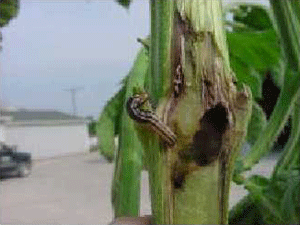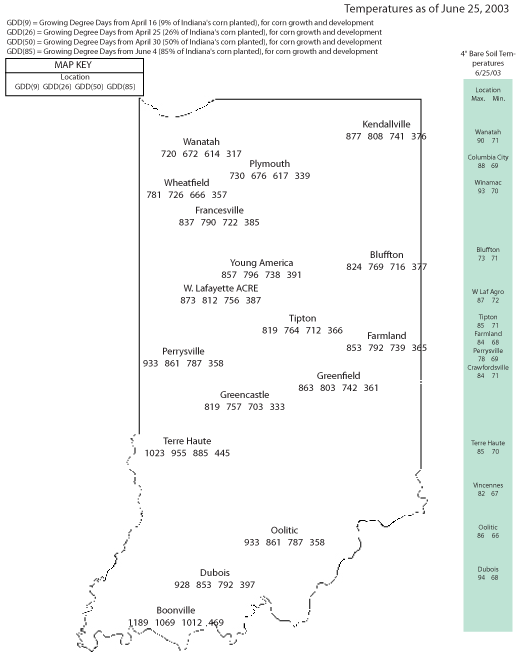Pest & Crop Newsletter
|
|||||||||||||
Soybean Aphid in Indiana– (John Obermeyer and Larry Bledsoe)
Soybean aphid, Aphis glycines Matsumura, was first found this year on June 11 at the Agronomy Center for Research and Education, Tippecanoe County, on V1 soybean plants. This was our first indication these aphids moved from their winter host, buckthorn, to their summer host, soybean. This is significant because it confirms that this aphid can survive a relatively harsh winter, something debated among entomologists. States in the northern Corn Belt observed this movement to soybean about one week earlier than we did, which has been the trend since 2001. Since our first observation of soybean aphid this year, numbers have been increasing in our research plots. Soybean aphid has a very complicated lifecycle. Simply put, female aphids feed-on and reproduce on soybean in the summer. Females give birth to female offspring, so aphid numbers can increase quickly (it is estimated that populations can double every 2-1/2 days). In the fall, as temperatures drop and days grow shorter, a generation of winged females and males are produced. Both migrate from soybean to their overwintering host plant Rhamnus, a shrubby tree also known as buckthorn. Eggs are laid on buckthorn, which overwinter and hatch in the spring. Aphids emerging in the spring are females. After several generations on the overwintering host, winged spring migrants fly to soybean to establish new colonies. The soybean aphid feeds by using a needle-like, sucking mouthpart to remove plant sap. Plant damage occurs from large numbers of aphids removing a significant amount of water and nutrients as they feed on leaves and stems. Plants with aphids are often stunted when compared to plants from other parts of the field. In some cases, heavily infested plants show dramatic leaf yellowing. This yellowing may be associated with potassium (K) deficiency, because symptoms can be more pronounced in fields where both high numbers of aphids and deficient levels of K are found. Aphids can become so numerous that plants are covered with shed aphid skins (resembling white powder) and honeydew, both of which are signs of aphid presence. Gray sooty mold growing on the honeydew can also cover leaves with a black, sticky film. It is too early to speculate on how severe the infestations will be in the Midwest, much less Indiana, for this season. Considerable time and effort has been and will be devoted to this pest throughout the Corn Belt because of its potential economic impact on soybeans. Indiana has had minimal crop damage due to this aphid since its discovery in 2000. At this point there is no standardized treatment threshold for this insect. However, the following conditions may indicate when insecticides may or may not be needed. Populations are becoming significant when there are at least 25 aphids per leaflet (3 leaflets for each trifoliolate leaf) and they are beginning to move from the undersides of leaves onto stems. Aphids on stems generally are easy to see without a hand lens. Honeydew is a sugary substance secreted by aphids as they feed and is a sign aphid numbers are large. The presence of ants will become quite apparent throughout the soybean canopy when honeydew is present. Leaves will darken as sooty mold increases. Beneficial fungi already exist in your fields, in the soil and on plant surfaces. These fungi infect aphids and can drastically reduce the aphid population in a field in a matter of days. Infected aphids are pinkish, white, or tan, and fuzzy from the growth of fungi out of their bodies. When weather conditions are warm and humid, the infection rate is rapid. Once a fungal infection starts, an insecticide spray may not be needed. Flowering and early pod fill during July seem to be critical times for aphid control. Large numbers of aphids feeding on the plant may cause flowers and pods to abort. Also, there are Minnesota data showing that node number was reduced by large numbers of aphids. Spraying too late in the season, once pods are formed, is probably too late to get the most yield advantage from treatment. Predatory insects, especially lady beetle adults and larvae, lacewing larvae, pirate bugs, and syrphid fly larvae, have been very abundant in infested fields and should provide some control, if present. Parasitic wasps, which lay eggs directly into aphids, have been less abundant, but still present. Parasitized aphids will be tan colored and stiff. There may be a small round hole in the skin of the aphid where the adult parasite escaped. In addition to the pathogenic fungi mentioned earlier, these biocontrol agents have the potential to dramatically reduce aphid numbers in Indiana to below economic levels. Efficacy trials have demonstrated that many products control aphids in soybean. The difficulty is in knowing if and when one should treat. Once an insecticide is used, predators are also controlled and aphids are able to quickly repopulate if left unchecked. Many experienced this type of phenomena with spider mites in 1988. Our caution is one should be absolutely certain that soybean aphid are threatening yield throughout a field and aware of extended weather forecasts before considering treatment. Further information with many color pictures can be found in extension publication E-217, Soybean Aphid (May 2001). This electronic publication can be viewed at <http://www.entm.purdue.edu/entomology/ext/targets/e-series/e-list.htm>.
Click for Table
|
|||||||||||||
Potato Leafhopper Update- (Ron Blackwell) As mentioned in last week’s newsletter, potato leafhopper populations are increasing. Sampling done in alfalfa (with fresh regrowth) in Tippecanoe County on June 26 revealed some threatening populations. The number of potato leafhoppers collected per sweep ranged from 1.6 to 8.7 in fields sampled. Regrowth was between 1 and 1.5 inches. The management threshold for alfalfa under 2 inches is 0.2 leafhoppers per sweep. Now is the time to get out there and scout those alfalfa fields! Refer to P&C #12 for sampling and management guidelines.
|
|||||||||||||
Weed Control Timing Isses in Roundup Ready Soybeans- (Bill Johnson, Glenn Nice, and Tom Bauman) Postemergence weed control operations in soybean should be well underway in most of Indiana. With over 85% of our soybean acres planted to Roundup Ready soybean, we have seen the use of postemergence weed control products shift from photosynthetic inhibitors (Basagran), diphenylethers (Cobra, Blazer/Status, Reflex/Flexstar) and ALS inhibitors (Scepter, Pursuit, Classic, Synchrony, etc.) to glyphosate-based products. Although we are shifting use patterns, we must still use sound judgment in selection of controllable spray application variables.
Unfortunately, my observations are that we are pushing the limits of the technology by making the first glyphosate application on weeds 8 to 16 inches tall (or taller – see photo). In discussing this with growers and consultants, it appears that the mindset is to make the application as close to crop canopy as possible to take advantage of the crop canopy in suppressing additional weed regrowth. When the herbicide is effective at controlling the large weeds, these programs have resulted in very clean fields. However, a clean field in August doesn’t mean that it will yield as high as it could have if the weeds had been controlled in a more timely manner early in the season. Our research has repeatedly shown that in a total postemergence Roundup Ready soybean system with moderate to heavy weed infestations, an initial weed control operation must be done according to one of the three criteria to minimize yield losses due to weed competition. These criteria consist of either 1) controlling weeds by 4 to 5 weeks after planting, 2) controlling weeds before they reach 6 to 9 inches in height, or 3) controlling weeds before soybean reaches the V3 stage of growth. Environmental conditions and weed densities and variety can slightly shift optimal management times in either direction for any of the criteria, but using one of these as a general rule of thumb will be the best way to minimize risk of yield loss. VC stage soybean and big giant ragweed. Although these weeds have just been sprayed (see yellowing in terminals), the timing of this spray application was a bit off in our estimation. We recommend against using this strategy. Photo was taken this year in Indiana by Dr. Bob Nielsen, Department of Agronomy. The name and location of the area are not given to protect the innocent.
Investigate Giant Ragweed and Marestail for the Presence of Stalk Boring Insects- (Bill Johnson, Eric Ott, John Obermeyer, Tom Bauman, Glenn Nice) A lot of attention is being devoted to weeds that appear to be escaping glyposate (Roundup, Touchdown, Glyphomax, others) treatments. While we do have pockets of glyphosate-resistant marestail in southeast IN, we are becoming more concerned about giant ragweed plants that do not appear to be controlled by glyphosate. In some cases, when the plant stems are split open with a knife, stalk boring insects and their tunnels are observed, particularly on plants 18 inches tall or larger. In some cases, I have split open small (less than 12 inch tall plants) and have not been able to find insect boring. By and large though, most of the escapes are large plants and in almost every instance, a stalk boring insect is present.
In response to this issue, we initiated greenhouse studies to look at the influence of stalk boring insects on glyphosate efficacy in giant ragweed. We have completed a couple of runs of this experiment and I wanted to share some of our findings to date. Methods: Preliminary Results: We are planning to continue to work on this issue and have also initiated field studies to study this interaction with natural insect infestations. Stay tuned for more details. In the meantime we are interested in these interactions in production fields and developing an informal database. If you are interested in how to collect data for this database, contact Bill Johnson, John Obermeyer, or Ron Blackwell. We would like to get a feel for both the number of escapes and plants controlled by glyphosate that contain stalk boring insects.
|
|||||||||||||
Tillers or "Suckers" in Corn: Good or Bad?- (Bob Nielsen)
Some of the guys over at the B&B Pitstop Cafe were arguing the other day about “suckers” in corn. The older fellows remember being sent to the fields as kids to pull “suckers” off the corn plants because their fathers believed that “suckers” were bad for the corn; although some suspected that the real purpose may have been to simply keep them out of their father’s hair on hot, muggy summer days. Well, what are “suckers” and are they bad for corn? “Suckers” Are Tillers Similar axillary buds at nodes higher up on the main stalk initiate ear shoots rather than tillers. Ear shoots differ morphologically from tillers in that internode elongation (within the ear shank) is less, leaves (husk) are shorter, and the stalk (ear shank) terminates in an ear (female inflorescence) rather than a tassel (male inflorescence). Sometimes, however, a tiller becomes “confused” during its development and generates a terminal inflorescence that is partially male and female (aka “tassel-ear”). Tillers on Normal Plants Tillering In Response to Damage Bottom Line Related References Nafziger, Emerson. 1998. Effect of Tiller Removal on Corn Yield. Univ. of Illinois. Available online at: <http://www.cropsci.uiuc.edu/research/rdc/report98/rpt98-12.html> [URL verified 6/22/03]. Poethig, R.S. 1994. The Maize Shoot. in The Maize Handbook (Freeling & Walbot, eds.). Springer-Verlag, New York, Inc. Thomison, Peter. 1995. Does Tillering Affect Hybrid Performance? Ohio State Univ., Columbus, Ohio. Available online at: <http://ohioline.osu.edu/agf-fact/0121.html> [URL verified 6/22/03]. Don’t forget, this and other timely information about corn can be viewed at the Chat ‘n Chew CafÈ on the Web at <http://www.kingcorn.org/cafe>. For other information about corn, take a look at the Corn Growers’ Guidebook on the Web at <http://www.kingcorn.org>.
|
|||||||||||||
|
|||||||||||||












